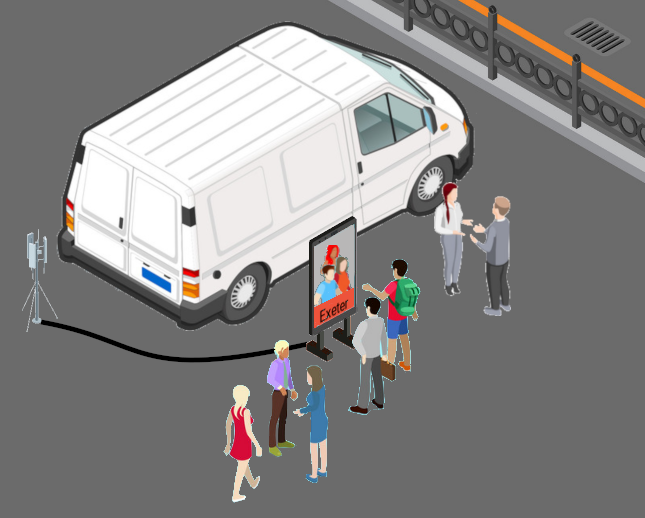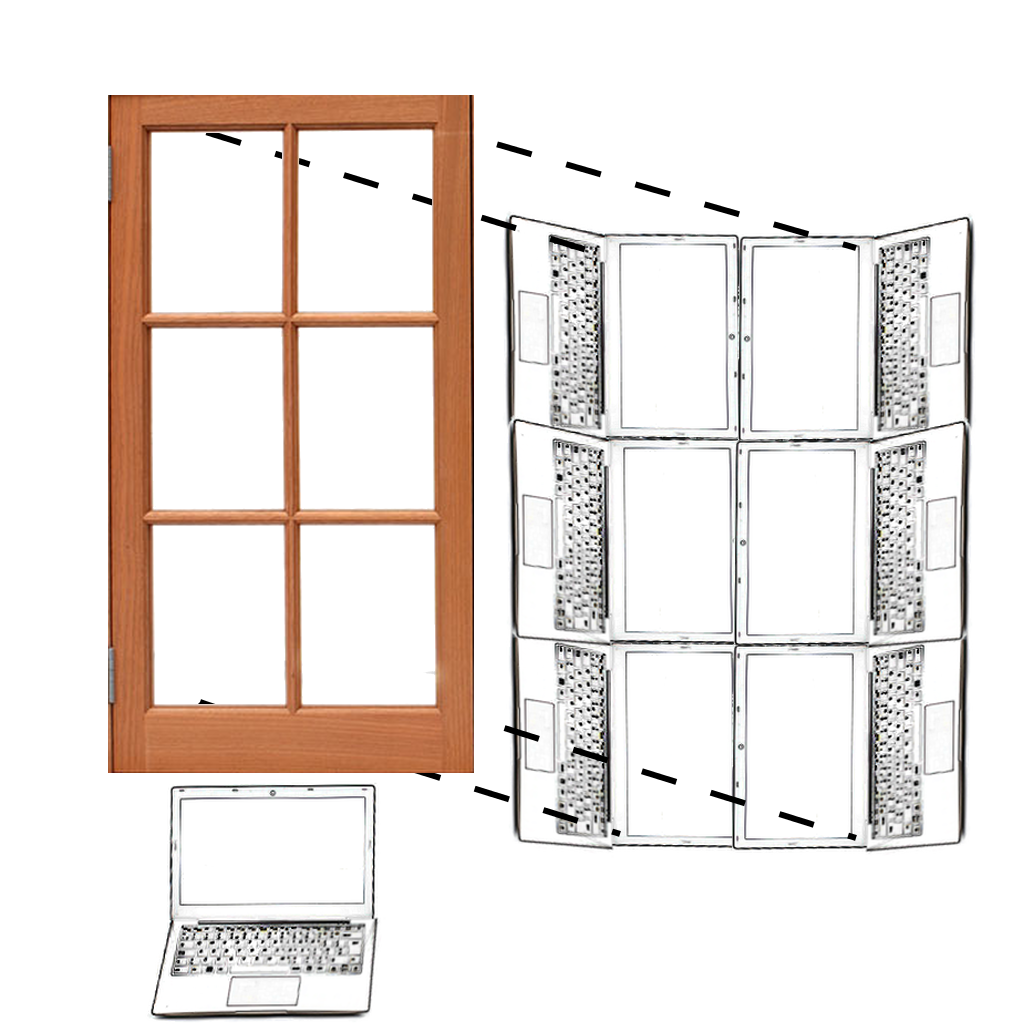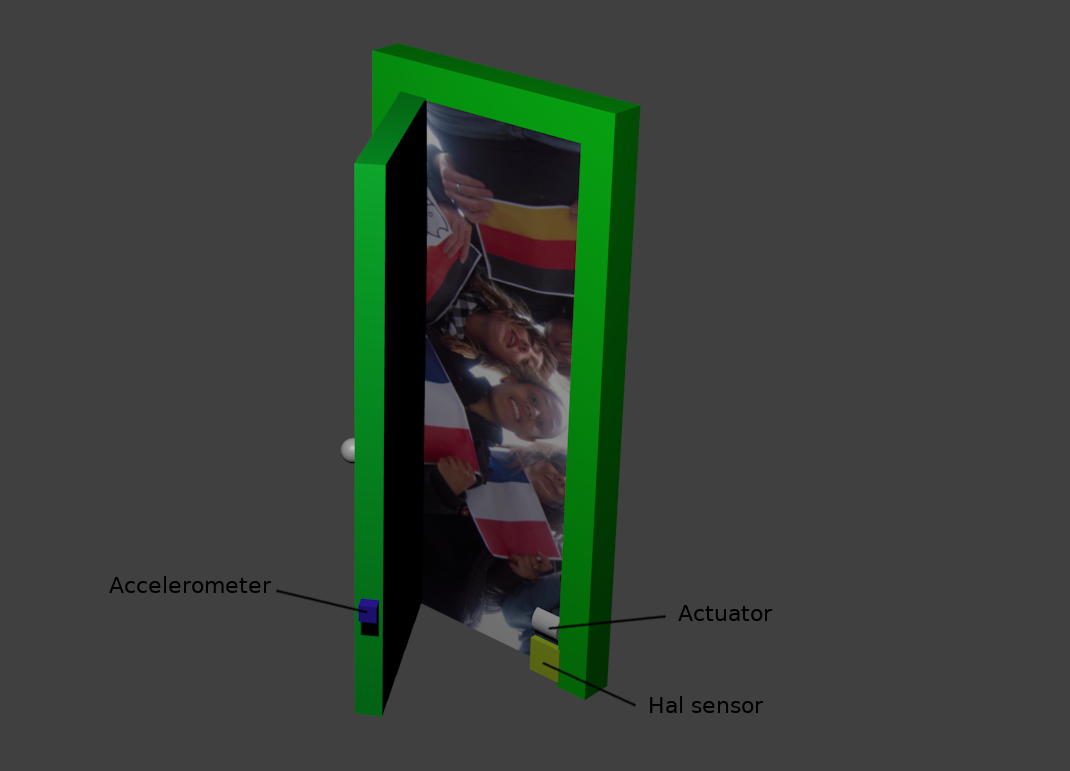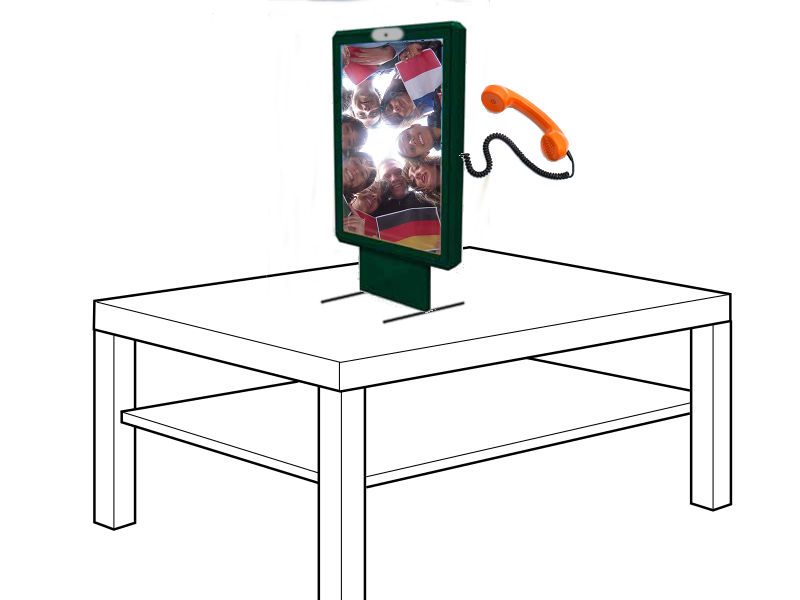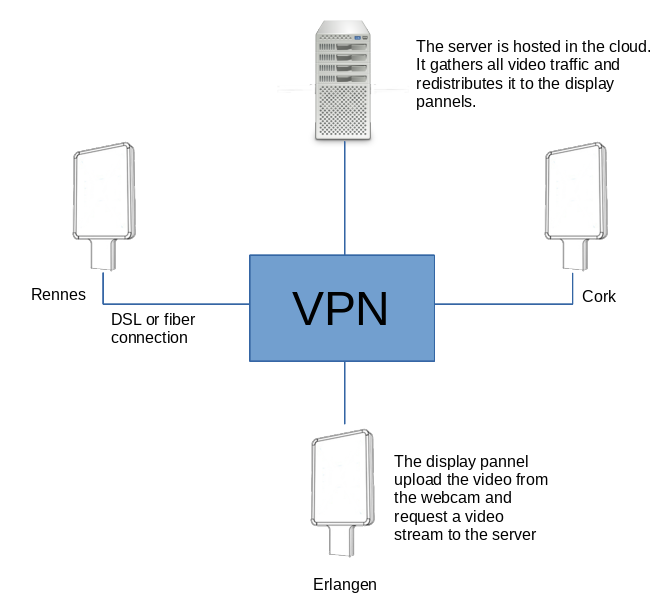-
"Van" version of the project
01/20/2019 at 18:09 • 0 commentsAs getting the authorizations to install streets screens or even using existing ones seems to be quite a challenge, I'm exploring a mobile version of the project:
![]()
The idea would be to have a setup that fits in a van and that can be powered by a big battery or a small gas powered generator.
The setup would include:
- an outdoor screen
- a load balancing router (pfSense or OpenWrt based)
- 2 x 4G/LTE modem
- IP webcam
- a power generator or a big ev battery
The video would either be streamed to a server that would distribute it to the other peers, or, if there is only 2 participants, it could just be sent to the other peer through a VPN. I think it would be better to have a video server to avoid all the problems related to mobile providers that don't provide a real, non NATed internet.
This project would need people to deploy the setup, present the project, and the twinned city to the people. and it could not be left unattended, but I think it is a solution that could be a good match for cities that want to get closer links with their twinned cities.
If you are interested and you live in Europe, don't hesitate to contact me to setup a european project, I'm looking for partners.
-
Projects for 2019 - Window on the world
01/11/2019 at 20:39 • 0 commentsHello dear Followers!
As a bright new year is starting, I thought I would write a log for each of my project.
This project didn't go as planned, at least no yet.
I was expecting some funding by the city but I didn't get it. The city seems interested by a lighter -non live- version of the project, it would use the already installed ClearChannel screens that are in the city center. I see this as a first step for the original "live stream in the street" project.
But I think it would be more realistic to have a mobile version of the project:
instead of having outdoor screens sealed on the ground, I think that it is more realistic to use vans to deploy movable outdoor screens and 4G/5G streaming system that will be installed during the day with people supervising the system. A temporary and autonomous setup would save a lot of red tapes and authorization requests, plus, it would allow to cover a greater number of cities.
Fortunately, there is a potential european funding for this project :
https://www.up2europe.eu/calls/town-twinning-2019-round-1_3370.html (account needed)
https://eacea.ec.europa.eu/europe-for-citizens/funding/town-twinning-2019-round-1_en (less details)If you are from Europe and have experience in European funding projects, don't hesitate to contact me. I already have potential partners but more wouldn't hurt!
I'll keep you updated, meanwhile I wish you a happy new year and a happy hacking!
-
Recycling 6 laptops into a single display
08/15/2018 at 13:23 • 0 commentsAs my previous prototype was closer from a door than a window, why not try to design another prototype that really looks like a window this time?
Also, after reading about upcycling and fab cities I'd like to reuse as much old hardware as possible. The idea is to recycle 6 laptops, each laptop screen acting as a "tile" of the window grille.![]()
Hardware
The goal is to reuse old laptops that are considered too old to be useful by common standards. Those laptops could also be used as cheap Linux terminals, but in my experience, there are more available old laptops than people willing to use old slow aging computers running Lubuntu (which is a great project by the way)
Another "master" PC can be used in addition to the other laptops if the video conversion and the webcam capture parts take too much time.
For this project to work, it is highly recommended to use identical laptops, because laptop screens differ a lot in luminosity, sizes, vision angles, etc.
So I will shortly be looking for local companies or public entities willing to get rid of old identical laptops.
If the PXE boot works, 5 of the 6 computer hard disks can be reused as an external storage. as the video will be broadcasted, and as there will be no complex desktop applications, A 100Mbits switch should be enough to deal with the network traffic.
A webcam is required, ideally we would take it from one of the laptops, but this can be a bit challenging. If it is not possible, we will use an old USB webcam. It must have a high enough resolution because we will display the image on 6 screens.
If we remove the hard drives and optical drives and disable unused USB ports, the laptops will use less power and maybe we could use 5 PSU instead of 6?Mechanical part
This part will depend on the laptops I'll pick for the project, for example :
- How to attach the laptops to the window frame?
- Will the air flow be good enough in the enclosure?
- How far can the screen be bent? Can it be easily detached?Software part
OS
The plan is to use a very light live Linux distribution that won't need to be installed on the hard disk.
This way the system could just be powered off by a switch.Boot
One "master" PC (one of the 6 "display" laptops or a separate one) will run a PXE boot server to allow the others to boot (like explained here)
Once booted, it will keep everything in RAM so it can be powered off without damages.
The bios could also be flashed to with an Etherboot payloadSending the video
One of the laptops PC or a separate PC will be in charge of sending the webcam video on the network. Nothing spectacular here, we will just grab the video from the webcam and send it in UDP
Converting the unicast video to multicast
This PC will receive the video stream from internet and re-stream it to the other pc in multicast, without any processing to avoid too much latency. All the computers will display one part of this stream but in full screen.
Another approach would be to use a high end network appliance running OpenWrt to do this part.
Displaying a part of a multicast stream.
This should be easy, ffplay or VLC should be able to do it.
In VLC wiki, I found this line : vlc input --vout-filter=crop --crop-geometry=120x120+10+10
There may be something to do to have a good synchronisation, like using a NTP server to synchronize all the laptops, we will take care of this once everything else work!So that's the plan so far!
After the holidays, I will contact Rennes'council to see if they are getting rid of old laptops or find a local company that does. If you know a company who's likely to get rid of 6 old laptops in the area, don't hesitate to PM me!
-
A more complex design for the indoor version
04/22/2018 at 05:25 • 0 commentsA simple screen can be a bit dull, so how can it be made fancier? I like the idea of a door, so let's add :
- an actual door that will open on the screen and on the camera. so if the door is closed, the user on the other side can't see you
- an accelerometer on the door, so it can detect if you knock on it, it's nicer than a simple button.
It could also be used to make a crinking noise when the door is being opened - an actuator (servo, vibrator) that can knock or "shake" the door a bit to make it looks like there someone else knocking on the other side
- a peephole with lenses and a proximity sensor
- a sensor that detects if the door is open
How it would work
Your door, A is connected to a single other door B
When you knock on your door A- It makes the connected door B shake
- once someone has opened the door B, your door A signals it can be opened.
In a first time, the signaling will be done with a sound or a light, but in a second time, we can imagine the door is locked and will only unlock if someone else open on the other side. - the video starts streaming
if nobody is on the other side, the "door" will ask you to try later and if you open it the screen won't display any video stream from the other side
Using the peephole
I like the idea of a peephole but I'm not sure how to make it interesting without being too invading for the privacy.
It will probably display a static image or a looping video of the other side, a bit like a profile picture, so you can know what to expect before you knock the door.
I don't know how to display the image, I can either add a 1" OLED screen inside the door, of I can just make a real hole in the door, add lenses, and a sensor so that when someone takes a peek, it switches on the screen and display an image on the part which is just in front of the peephole, this way of doing is a bit more hackerish ;-)Half skype, half chatroulette
In the original concept case the connectivity is simple a door A is always linked to a door B. But we can imagine a more dynamic connectivity where, when a user knock on a door a requests is sent on a server to find a peer. Or you can make other rules like "a door opened in a museum will always open on a door located in another museum, a door in your hackerspace will always open on a door in another hackerspace" etc.
You could also put restrictions on the language used, and for example only request Spanish speaking door if the door is located in your Spanish language exchange club, etc.But honestly this feature would only make sense if hundreds of "doors" are in use, or if there is a software version, let's focus on something more realistic first ;-)
Illustration
![]()
-
Indoor version - simple design
04/14/2018 at 06:34 • 0 commentsHere is an illustration for a possible indoor version :
![]()
Experimented eyes will recognize the Ikea table I stole from a PDF manual...
I definitevely have to learn how to use better tools that can do 3D ;-)Basically the indoor version could be a scaled down version of the original, but with a handset, so that the sound would not be to disturbing for those who don't communicate.
I think it is important for this object to cohabitate with other activities taking place in the room, as it is supposed to be located in places that already have a purpose.
There can be several versions, some with wifi, some with 4G or lan, some with batteries and some which are plugged on the wall.
I have plans for a more complex indoor version, but I need to learn how to use CAD or 3D modeling tools first to be able to properly illustrate it.
AI also created a project page on up2europe :
-
Similar projects
10/28/2017 at 17:57 • 0 commentsI looked for similar projects on internet, here is what I found :
- SNCF advert
It's clearly a mockup(not a live footage) or at least staged for the advert. But the idea of a door is quite nice.
- Sharing faces art installation
It was also temporily installed in my city, Rennes, but unfortunately I missed it.
- A well between between China and France
I've heard about this one but I couldn't find it on internet...
-
Let's get technical!
10/21/2017 at 08:44 • 0 commentsHere are some thoughts on various technical parts of the project:
Inside the display panels
I would imagine a SBC like a Raspberry Pi or a Beaglebone board would do OK. Raspberry pi seems to be better at decoding video(it can decode 1080p), so I think we will opt for it, maybe with active cooling since it must run outside for long periods of time.
For the display, a standard 50" HDMI display will do, we must be able to shut it down from the SBC. It can be useful -and sometimes legally required- to shut down the display at night, and we can use a PIR/Ulstrasound sensor to only activate the screen when someone passes by.
The server should have a watchdog to reboot in case of problem. They should be able to display images if there is a connectivity problem.
When I checked modern 50" TVs, I noticed that a lot of them offer an Ethernet port and run Android with sometimes up to 2Go of RAM! It means I wouldn't have to use a Pi, but I don't trust TV manufacturers to provide good support for their Android stack, and setting up something like VPN on them might be tricky.Sending images
We can have a dedicated ethernet webcam or we can plug a regular USB webcam on the SBC.
It will be cheaper to have an USB webcam, also it is easier to update. We will have to see if a standard consumer webcam can run for hours, they may not be designed for this and overheat a bit.
Another possibility would be to plug a DSLR to the Pi, it would allow us to focus on the person in front of the panel and to have only a blurry view of the crowd. In some countries, the law doesn't allow you to film people without their consent, so it could be useful.
On the software side FFMPEG can stream a webcam stream using UDP or RTSP, we may build a custom application based on it if needed.Network
I think it is better to use a client-server architecture rather than a p2p one. Sending the video streams to a server will allow to process the video instead of just forwarding it.
Also it will be useful to have a VPN, it will be safer and it will also allow us to use multicast if needed.![]()
Server
I see 2 different kind of servers:- Video playing server
I want to use an open source solution, like Nginx for example which has a RTSP plugin, it will allow us to serve the video to the SBC requesting it.The server should also be able to play prerecorded streams if there is some connectivity problem
- Video playing server
Window on the world
Screens in the streets and in art centers to make video exchanges between cities
 PixJuan
PixJuan